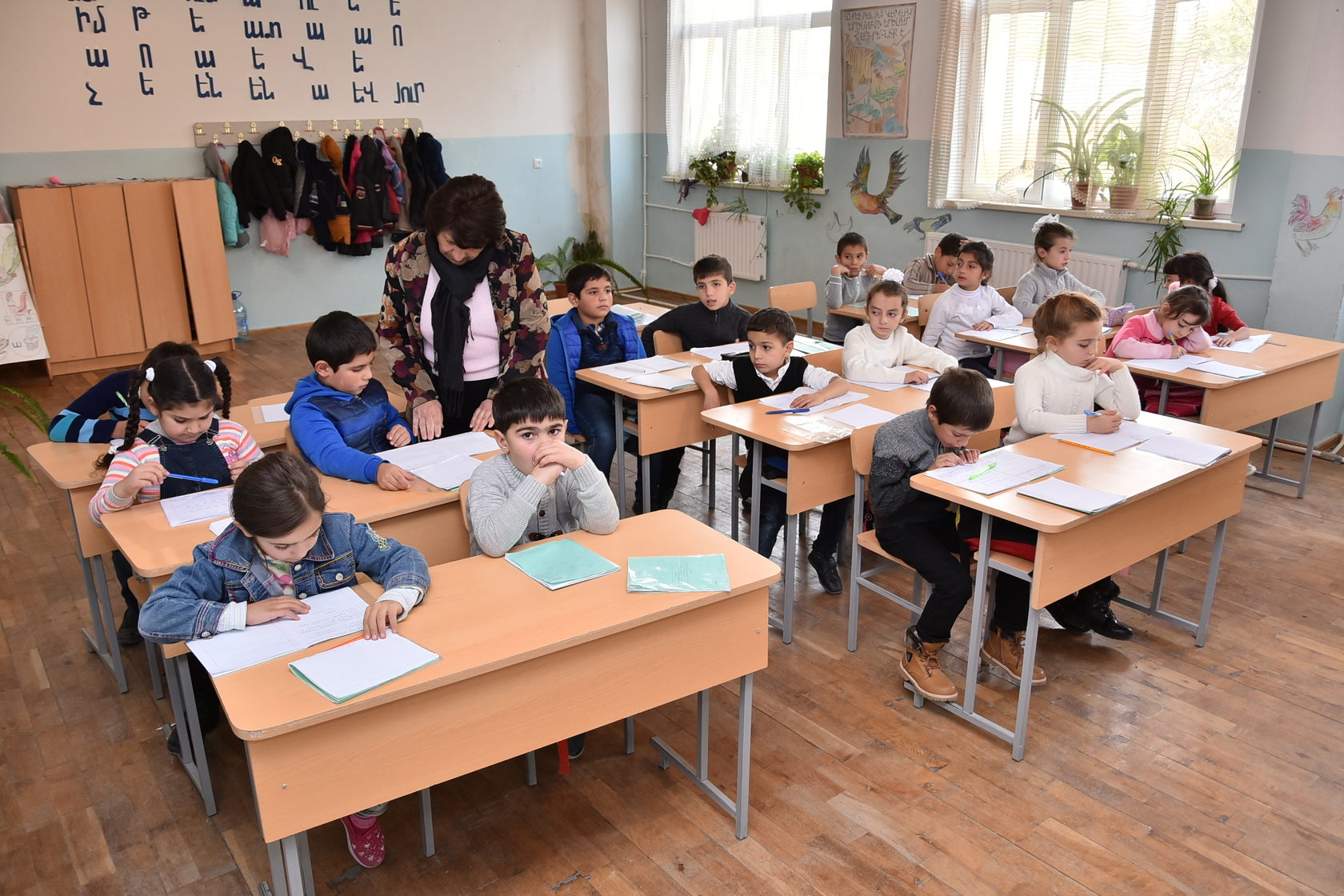Greenhouses of health
How to improve a schoolchild’s diet
SIFI and UN FAO joint publication
In this book, we will try to show and tell you how the inclusion in the diet of schoolchildren of fresh vegetables and herbs grown on the school grounds will allow you to diversify the menu, enrich it with useful vitamins and minerals, so necessary for the healthy development of the child’s body. Climatic conditions, as well as the availability of free space in the territory of many schools in Armenia, are a stable base for creating school greenhouses, where you can grow products for school meals.
This publication we would like to commend to your attention is devoted to the pilot “School Food and Nutrition Program linked to the Agricultural Sector” that is currently implemented in the Republic of Armenia by the Food and Agriculture Organization of UN under the project “Developing Capacity for Strengthening Food Security and Nutrition in Selected Countries of the Caucasus and Central Asia” funded by the Russian Federation. The FAO project, among other activities, assists the Government of Armenia in improving the effectiveness of the National School Feeding Programme and creating sustainable value chains, testing various models of vegetable production in greenhouses in school areas.
Back to
Sunny Armenia
Hospitable Armenia is putting its arms out to welcome all its guests! Here in Armenia you’ll have an opportunity to immerse yourself in the spirit of the ancient culture of the Armenian people, get to know its authentic cuisine, and, of course, get to sample some of the region’s delicious fruits and vegetables, the pride and joy of any Armenian.
With its super-clean water and its 300 sunshine-filled days a year, Armenia is an amazing mountainous country that features over 30 types of soil, which, for instance, is why one and the same variety of grapes may have different flavors in Armenia.
With its super-clean water and its 300 sunshine-filled days a year, Armenia is an amazing mountainous country that features over 30 types of soil, which, for instance, is why one and the same variety of grapes may have different flavors in Armenia.
Armenia


Boarders with:
90% of the territory of Armenia is located at an altitude of 1000 m above sea level.
The highest point of the country – mountain Aragats (4095 m)
The highest point of the country – mountain Aragats (4095 m)

Capital
Yerevan




Currency
Official Language
Form of Government
Total Area
Armenian Dram
Armenian
Republic
29 743 sq km





Population size
2,9
mln
52,5%
47,5%
Average life expectancy at birth – 74 years
Poverty
39,4%
Families receiving social benefits
111 806
Iran
Turkey
Georgia
Azerbaijan




The major cultivated crops include vegetables and gourds, potatoes, wheat, grapes, and tobacco, with horticulture practiced as well, especially growing peaches and apricots.
Armenia is a mountainous country with non-uniform terrain and vertical zonation. Just 46% of Armenia’s territory is used for agriculture. The total area of cultivated land is about 4.5 thousand square kilometers.
Curious facts about Armenia or According to Armenian radio …


Volumes of agricultural production
$ 1,9
billion
Gross agricultural output (in 2017)
5,7%




Plant growing
Animal husbandry
89,3%
5%
Fishing




64%
Level of self-sufficiency in essential food products
Согласно Национальной службе Статистики Республики Армения
Production volumes (thousand tons):
209,9
215,8
302,4
361,6
547,4
861
Grape
Melons
Wheat and legumes
Fruits and berries
Potato
Vegetables






17%


8,6%
49,9%
46%

9,7%
11,1%

Dynamics (compared to 2016)



School plate
Within the framework of the National Program, the Government allocates 140 drams per child/day, of which 20 drams are allocated to pay for the work of food service employees, and the rest for the purchase of food products.

Flour

Within the framework of the Sustainable School Feeding development project, WFP supplies 6 types of products to schools in 6 regions of Armenia:

Shirak
09/2018
Tavush

09/2017

Aragatsotn
2019

Ararat
01/2015

Vayots Dzor
09/2014

Syunik
09/2014








Oil
Peas
Pasta
Buckwheat
Rice
41%
59%
102 000
Beneficiaries
It’s clearly a pity if there’s fertile soil under your feet but you still have to buy vegetables and fruits from the market.
Across the Ararat plain, many schools have long considered the possibility of having orchards and kitchen gardens of their own. The boldest dream is to have a greenhouse of your own which will yield harvests nearly all year round.
Across the Ararat plain, many schools have long considered the possibility of having orchards and kitchen gardens of their own. The boldest dream is to have a greenhouse of your own which will yield harvests nearly all year round.

Apricot
What's inside?
Potassium — for the health of the heart and blood vessels
Carotene — for sharp vision and elastic skin
Inulin — for normalizing weight
Calcium and iron — for proper brain function and bone growth
Potassium — for the health of the heart and blood vessels
Carotene — for sharp vision and elastic skin
Inulin — for normalizing weight
Calcium and iron — for proper brain function and bone growth
Harvest — May-September

Apple
What's inside?
Iron — to prevent anemia
B vitamins — to digest fats and sugars
Vitamins A, C, E — to increase the body's defenses
Phosphorus, magnesium and potassium — for brain, heart and muscle function
Iron — to prevent anemia
B vitamins — to digest fats and sugars
Vitamins A, C, E — to increase the body's defenses
Phosphorus, magnesium and potassium — for brain, heart and muscle function
Harvest — June-November

Peach
What's inside?
Fructose, fiber — to saturate the body
Fruit acids — to speed up metabolic processes
Potassium — eliminates electrolyte imbalance
Fructose, fiber — to saturate the body
Fruit acids — to speed up metabolic processes
Potassium — eliminates electrolyte imbalance
Harvest — June-November

Pomegranate
What's inside?
Pantothenic acid — to normalize metabolism
Folacin — improves hematopoietic function
Pectin and tannins — to combat inflammation
Pantothenic acid — to normalize metabolism
Folacin — improves hematopoietic function
Pectin and tannins — to combat inflammation
Harvest — November-December

Tomato
What's inside?
Pectins — for better bowel function
Choline — to reduce cholesterol levels and liver health
Ascorbic acid — for appetite and body protection
Folic acid — to improve metabolism
Pectins — for better bowel function
Choline — to reduce cholesterol levels and liver health
Ascorbic acid — for appetite and body protection
Folic acid — to improve metabolism
Harvest — May-September

Cucumber
What's inside?
Water containing dissolved mineral salts
Potassium, silicon, sulfur, iodine, fructose and fiber — for digestion
Tartranic acid — for carbohydrate-fat metabolism
Water containing dissolved mineral salts
Potassium, silicon, sulfur, iodine, fructose and fiber — for digestion
Tartranic acid — for carbohydrate-fat metabolism
Harvest — May-September

Eggplant
What's inside?
B vitamins — for strong nerves and healthy sleep
Ascorbic acid — for protection against colds
Folic acid and iron — for healthy growth and energy
B vitamins — for strong nerves and healthy sleep
Ascorbic acid — for protection against colds
Folic acid and iron — for healthy growth and energy
Harvest — May-September

Coriander
What's inside?
Organic acids — for good digestion
B vitamins — for brain function, good skin and metabolism
Pectin — to improve intestinal motility
Rutin — to combat “bad” cholesterol
Organic acids — for good digestion
B vitamins — for brain function, good skin and metabolism
Pectin — to improve intestinal motility
Rutin — to combat “bad” cholesterol
Harvest — April-October
The economic effect from growing vegetables on a plot of your own is unmistakable.
Each month, the parents of schoolchildren at each of the schools collect an average of 500 drams (USD 1.04) per person for the purchase of additional vegetables and other products.
With a greenhouse of its own in place, a school could buy with the proceeds not only additional vegetables for the cafeteria, but meat, cheese, legumes, eggs, or fermented milk products as well. This could help to significantly diversify children’s diets and cook them more nutritious dishes.
Each month, the parents of schoolchildren at each of the schools collect an average of 500 drams (USD 1.04) per person for the purchase of additional vegetables and other products.
With a greenhouse of its own in place, a school could buy with the proceeds not only additional vegetables for the cafeteria, but meat, cheese, legumes, eggs, or fermented milk products as well. This could help to significantly diversify children’s diets and cook them more nutritious dishes.
In organizing their procurement process, schools may have a hard time monitoring the quality of produce – after all, not every farmer in the market has a proper certificate.
It goes without saying that the top priority everywhere is the safety of meals in the school cafeteria. With their own agricultural plots and greenhouses in place, schools could feed the kids five days a week with safe, high-quality, and fresh organic produce.
It goes without saying that the top priority everywhere is the safety of meals in the school cafeteria. With their own agricultural plots and greenhouses in place, schools could feed the kids five days a week with safe, high-quality, and fresh organic produce.

Greenhouses could be not just a source of nutrients essential for healthy eating but serve as a training center as well. School principals and future greenhouse personnel are, normally, the first ones to undergo training. Specialists at the Farm Service Center in Darakert have provided training for these individuals, teaching them how to prick out seedlings and organize the irrigation and maintenance processes.
In addition, now each greenhouse worker has at hand a special Guideline that provides a detailed account of the key varieties of cucumbers and tomatoes and outlines the nuances of looking after the plants and curing them if the need arises.
The schoolchildren and teachers do not stay on the sidelines either. The children are taught a special course on healthy eating and the basics of hygiene, botany, and agriculture. The teachers are provided with instructional guidelines, and the children – with workbooks filled with colorful illustrations and tasks.

Greenhouses could be used as a base for the training of not just schoolchildren but their parents too, as well as local farmers who would like to improve their knowledge of the latest technology in the field. In addition, after establishing a good relationship with the school, each “student farmer” will get the chance to supply to the school some of the produce grown on their own plot.

Capital
Vegetable gardens of the future


Varin Artashat
Vedi
Yerevan
Drip irrigation system
Project objectives
Increasing the nutritional value and diversity of schoolchildren's diets
Creation of additional sources of funding for school meals

Greenhouse heating system

Surenavan
Surplus crops could be sold at the local market. The proceeds could be used to purchase additional products, as well as directed toward repairs and upkeep around the cafeteria.
The greenhouses, fitted out with state-of-the-art drip irrigation and heating systems, will be cropped with cucumbers, tomatoes, peppers, onions, and herbs.

Small greenhouse
Just about any kid has been wished good health on their birthday. But, to ensure they grow as healthy individuals, full of vim and energy, their diets should definitely contain fresh vegetables and herbs.
The pilot associated with building a small greenhouse has a specific objective – to help School No. 1 in the town of Vedi ensure that, regardless of weather conditions, the kids can receive a guaranteed supply of vitamins nearly all year round – right from the school bed.




Total number of students
Cucumbers
A small greenhouse at School No. 1 Vedi meets the school's needs for vegetables and greens.
sq m

626

306
129

Number of students
1-4 grades
1-4 grades
Production
territory
territory
Harvest
Tomatoes
Onion
Pepper
Greens
In mid-June, Vedi’s School No. 1 arranged a gathering of schoolchildren, the motive being not a summer camp but to celebrate their first harvest. They call this ‘nubar’ in Armenia.
Despite being the smallest of the three greenhouses set up as part of the FAO pilot, its tomato harvest was really excellent this year.
A couple of years back, the school started growing potatoes, and some parents who are farmers would help with advice. They’d also planted several fruit-trees – prunes, apples, and apricots.
It turns out that many vegetables do not grow too well in the neighborhood of potatoes, so that would become a major concern for those at the school. Fortunately, the new irrigated greenhouse did the trick for them.
Despite being the smallest of the three greenhouses set up as part of the FAO pilot, its tomato harvest was really excellent this year.
A couple of years back, the school started growing potatoes, and some parents who are farmers would help with advice. They’d also planted several fruit-trees – prunes, apples, and apricots.
It turns out that many vegetables do not grow too well in the neighborhood of potatoes, so that would become a major concern for those at the school. Fortunately, the new irrigated greenhouse did the trick for them.
The school nutrition program was instituted in Vedi in 2013. Since then, a major portion of parent contributions has been going to the purchase of vegetables, which kids like so much.
“You should see them eat salads! Among the top favorites are fresh vegetables salad and vinegret. But a real surprise for us was to see how eagerly our children consume pickled vegetables”, says Principal Advard Papoyan.
“We’ve fallen in love with our greenhouse. My day starts with visiting the greenhouse, where I always caress the sprouts and say ‘good morning’ to the plants”.
“You should see them eat salads! Among the top favorites are fresh vegetables salad and vinegret. But a real surprise for us was to see how eagerly our children consume pickled vegetables”, says Principal Advard Papoyan.
“We’ve fallen in love with our greenhouse. My day starts with visiting the greenhouse, where I always caress the sprouts and say ‘good morning’ to the plants”.
Medium Greenhouse
The brand-new greenhouse at the main school in the Verin Artashat village will be used to grow more tomatoes than the cook is prepared to utilize in the cafeteria and the schoolchildren are able to consume.
Why so much, then? The thing is that the sale of surplus crops will help the educational facility in resolving its various existing problems.




Total number of students
Cucumbers
The medium-sized greenhouse in the Verin Artashat school provides the school with vegetables and greens.
The surplus will be sold (the profit will be used to develop the school infrastructure).
The surplus will be sold (the profit will be used to develop the school infrastructure).
sq m

457

204
384

Number of students
1-4 grades
1-4 grades
Production
territory
territory
Harvest
Tomatoes
Onion
Pepper
Greens
“Sometimes the school does not have enough money to even buy chalk, let alone fund repairs to the cafeteria or upgrades to the school inventory”, confesses Principal Grigor Yesayan. “We all understand it’s been tough for the schools. But now I’m going to know by the start of a year, when it’s time to purchase 50 plates for the cafeteria, that the school has the funds for that”.
However, the school still lacks experience in sales for now. “The market is, of course, dominated by large vendors. But our produce is of higher quality. I don’t know what the prices will be, but we’ll always strive to make sure not a single tomato is wasted. We’ll make deals with supermarkets and buyers and work with processing enterprises. And, of course, we’ll be sharing our produce with neighboring schools”.
However, the school still lacks experience in sales for now. “The market is, of course, dominated by large vendors. But our produce is of higher quality. I don’t know what the prices will be, but we’ll always strive to make sure not a single tomato is wasted. We’ll make deals with supermarkets and buyers and work with processing enterprises. And, of course, we’ll be sharing our produce with neighboring schools”.
The economic effect from the construction of a greenhouse was first felt by personnel at the cafeteria of the school in Verin Artashat. Assisted by the steward, they look after the plantings. They get paid by the hour for doing this type of work, including during the summer break. “This extra income is a substantial aid for cooks at the cafeteria, who make just 13 000 to 14 000 drams (around USD27–29) per month”.

Large greenhouse
In tiny Armenia, not every school is lucky to own a large plot of unused land. For smaller educational facilities, most of which lack land and personnel, keeping a greenhouse is a tall order.
The FAO suggests turning for fresh and nutritious vegetables to a generous neighbor with a big greenhouse and rich harvests.




Total number of students
Cucumbers
A large greenhouse in Surenavan will provide vegetables and greens for the students of the school itself, as well as neighboring schools.
The surplus will be sold (the profit will be used to develop the school infrastructure).
The surplus will be sold (the profit will be used to develop the school infrastructure).
sq m

303

137
528

Number of students
1-4 grades
1-4 grades
Production
territory
territory
Harvest
Tomatoes
Onions
Pepper
Greens
The school could only dream of running a large greenhouse of its own. “Everyone was surprised, as they’d hardly believed something like this was possible and the school could have a greenhouse of its own – and one this big at that. In fact, as far as I know, no one in Surenavan has a greenhouse”.
Workers at the school are just learning how to grow cucumbers and tomatoes. There are plans to ensure that fresh vegetables will appear on the tables nearly all year round at neighboring schools as well, with which the Surenavan school is going to share its rich harvests. Vegetables will be supplied to schools with no land for organizing a kitchen garden or a greenhouse. Surplus crops will be sold, and the proceeds will be directed toward ambitious projects.
Workers at the school are just learning how to grow cucumbers and tomatoes. There are plans to ensure that fresh vegetables will appear on the tables nearly all year round at neighboring schools as well, with which the Surenavan school is going to share its rich harvests. Vegetables will be supplied to schools with no land for organizing a kitchen garden or a greenhouse. Surplus crops will be sold, and the proceeds will be directed toward ambitious projects.
Lessons from nature
«Nature is a book that one has to read and understand the right way, as understanding it the wrong way may result in great harm»
Mikael Nalbandian
Mikael Nalbandian
As soon as a schoolchild sets foot into a greenhouse, they find themselves in a green domed kingdom filled with the scent of their native land and the aroma of ripening fruits. Afterwards, they will come in here more than once to look around, take part in sowing seeds, and help adults look after the plantings or water the beds. But it is the first sensation of an impressionable child, who is looking at the world with eyes wide open, that will imprint in their memory forever.

Greenhouses represent a symbiosis of nature and human thought. For children, watching plants grow and develop, as well as witnessing some of the latest technology operate (e.g., cutting-edge irrigation systems) is a unique opportunity for them to gain key practical skills and knowledge. Who knows, maybe the child will be able to infect with enthusiasm their parents, who, in turn, could come over to the school, have a “sneaky peek” at the state-of-the-art greenhouse, and then go back home and start a similar holding of their own.
This photo-book was prepared by the Social and Industrial Food Service Institute from Moscow (Russian Federation) during the implementation of the pilot "School food and nutrition program linked to the agricultural sector” in the Republic of Armenia.
The pilot is a part of the comprehensive project “Developing Capacity for Strengthening Food Security and Nutrition in Selected Countries of the Caucasus and Central Asia” that is funded by the Russian Federation and implemented by the Food and Agriculture Organization of the United Nations.
The pilot is a part of the comprehensive project “Developing Capacity for Strengthening Food Security and Nutrition in Selected Countries of the Caucasus and Central Asia” that is funded by the Russian Federation and implemented by the Food and Agriculture Organization of the United Nations.
The project seeks to promote cross-sectoral collaboration by providing adequate capacity to effectively pursue and manage coherence between agriculture, nutrition, health, education and social protection sectors. The cooperation comprises support to a wide array of development initiatives at regional and global level.






